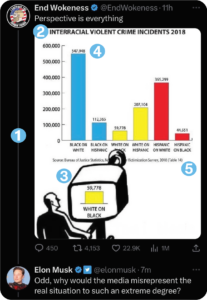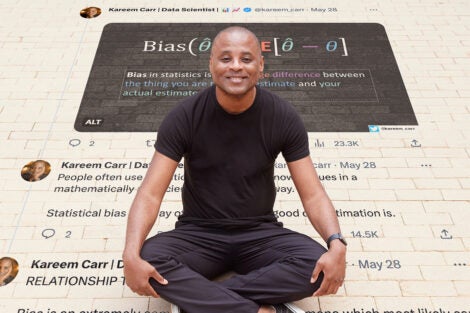Biostatistics PhD candidate Kareem Carr turned into a Twitter star by debunking deceptive charts. He explains why he addresses misinformation on social media—and how scientists and academics can do it well.
October 20, 2023 — Kareem Carr isn’t leaving X (formerly known as Twitter) any time soon. A PhD candidate in biostatistics at the Harvard Kenneth C. Griffin School of Arts and Sciences who studies the genomics of the circadian rhythm at the Harvard T.H. Chan School of Public Health, Carr spends much of his free time engaging with the public on social media. “I want what I’m doing as an academic to be relevant to people outside of academia,” he says. “I almost see it as a duty.”
Carr, who calls himself “your friendly neighborhood statistician,” has a knack for combating disinformation on social media, where conspiracy theories abound and racism can be overt.
His posts often receive high levels of engagement, with some viewed by millions around the world. His goal: to reach people who are curious and open to learning how data can be manipulated. “People tend to think collecting numbers is always neutral. That’s how bigotry gets laundered,” he says. “And then there are those people who see a graphic and immediately know it’s racist, but they don’t have the arguments to push back. I try to give those people arguments they can use.”
Internet fame can be dizzying—and addictive. Carr says he learned quickly not to turn to his followers for support. “The internet is a bad friend. It’s not there for you when you need it,” he says. “My coping strategy is to have boundaries.”
That means setting up designated times to check his notifications and making sure to close the app entirely if the phone won’t stop buzzing. It also means staying away from social media altogether when he’s not in the right head space. This is especially important when Carr, who is Black, is barraged with racist comments. “I don’t want [Twitter] to end up setting the tone of my day—either in a good or in a bad way,” he says. “You need to do a lot of self-monitoring.”
Carr grew up in Saint Kitts and Nevis and moved to the U.S. to attend college at Illinois State, where he majored in physics. After completing a master’s in mathematics at New York University, he had stints at the National Bureau of Economic Research and Harvard University, where he was a fellow in both the Department of Molecular and Cellular Biology and the Institute of Quantitative Social Science. He also worked as a computational biologist at the Broad Institute, the joint biomedical and genomic research center of Harvard University and MIT.
He says his years at the Harvard Chan School have taught him a great deal, both by exposing him to new topics—Linda Kaboolian’s negotiation class was a favorite—and by connecting him to a network that pushed him to accomplish more than he had imagined he could. “The work is intense and demanding. It’s like a mountain you have to climb, and you don’t think you can climb it—but everyone else around you is so gung ho that you feel like you should do it, too. Lo and behold, you make it to the top.”
After graduation this fall, Carr wants to write a book about what statistics has taught him about the world—namely, that uncertainty is at the core of the human experience. “We pretend it doesn’t exist or we look at it like a problem,” he says. “I want to give people a framework to understand uncertainty and help them make decisions with more clarity.”
Kareem Carr’s tips for debunking disinformation
 Carr says, “It’s important to address false or deceiving claims when we come across them because people tend to believe them if they are repeated again and again–a phenomenon known as ‘the illusion of truth.’” Here are three strategies:
Carr says, “It’s important to address false or deceiving claims when we come across them because people tend to believe them if they are repeated again and again–a phenomenon known as ‘the illusion of truth.’” Here are three strategies:
1. Bad actors crave visibility. Don’t give it to them.
It’s easy–especially when you have many followers–to end up further spreading the very posts you intended to debunk. Resist the temptation and only address those that are already receiving significant attention.
2. Pick your fights. Be strategic.
Some issues are more important than others. For example, at the height of the pandemic, I didn’t push back against every inaccurate tweet I saw, but focused on promoting what we knew would keep people safe, such as masks and vaccines.
3. Keep it simple.
In academia, we tend to like very complicated arguments. This doesn’t work with the public. Instead, make your point as simple as you can–then try to make it even simpler.
Anatomy of a Twitter takedown, with Kareem Carr

This past May, Elon Musk engaged with a graph on race and violent crime, spreading its misleading message. Carr responded with threads breaking down both its racist framing and sloppy data science. Here, he explains his key points.
1. This is not the right way to look at data. The graph is univariate, ignores causation, and relies on only one source of evidence.
2. What scientific question is it trying to answer? By structuring crime data exclusively through the lens of race, it implicitly sets up a racially antagonist framework. It is true that some crimes, such as hate crimes, are racially motivated. In those specific cases, it makes sense to isolate race as a causal element.
3. The media likely focuses on racially motivated crime as a subset of all crime. It makes more sense statistically to investigate crime according to causal mechanism.
4. The graph emphasizes the racial angle in subtle ways. It excludes data on crimes where both the victim and offender are the same race, which are the vast majority. The original data reports percentages of offenders by race for each type of victim which makes it easy to see that White victims were experiencing crime from Black offenders at approximately the rate of Black people in the U.S. population. The graph converts these percentages to raw numbers. This makes Black on White crime seem huge because there are more White Americans compared to other groups.
5. This graph leaves out other relevant factors, such as age and wealth—areas where there are significant differences between Black and White people. For example, younger Americans tend to commit violent crimes at higher rates than older Americans, which weakens the claim that different crime rates are due to race alone.
Photos: Kent Dayton
